Before the 359 lives were lost and 1,074 more injured; before the battle, the carnage, and eventual victory, thousands of Canadian soldiers opted to bid farewell to sedate domesticity and converged on Halifax, ahead of what was the largest seaborne invasion ever attempted.

“The last glimpse of Canada that many of these soldiers had, in some cases ever, was the sight of the coast of Nova Scotia,” said Ken Hynes, the chief curator of the Army Museum.
Operation Overlord, or D-Day as it’s now better known, involved around 50,000 vehicles, 11,000 aircraft, 5,000 ships and 150,000 Allied troops. About 14,000 of those troops came from different communities across Canada.
The invasion of Normandy on June 6, 1944, is viewed as one of the pivotal points of the Second World War in Europe.
READ MORE: Remembering D-Day: These brave Canadians saw the action
More than one-million uniformed men and women served in the Second World War, with several embarking on ships through Halifax between 1939 and 1945. In the late ’30s, Halifax’s population was around 60,000.
“Halifax was probably a pretty busy place, as you can imagine, with a huge influx of sailors and soldiers and airmen at that time,” Hynes says.
“The population, which was not even 100,000 at that time, would probably have some cases been pretty close to double that.”
WATCH: D-Day veteran’s harrowing tale of advancing deep behind Nazi lines

Halifax is also where the majority of soldiers would return between 1945-46.

Get breaking National news
“You can imagine a guy with a couple of kids, and he leaves in 1939-1940, and the next time he sees his wife and children is 1946, it kind of puts things into perspective,” Hynes said.
A changed city
As Canadian soldiers ventured to the East Coast throughout the duration of the Second World War, there were a number of defence installations in place in Halifax. Citadel Hill, Point Pleasant Park, and York Redoubt, in particular, were teaming up to defend the port from the German submarines.
“Halifax was heavily engaged in providing that kind of defence so the port a) could operate and b) could provide all of the troops and all of the supplies that left North America that went overseas to England and then later on into Europe,” Hynes said.
“Those guys had no idea how long they were going to be gone.”
READ MORE: Remembering D-Day: How the Allies broke through Hitler’s ‘Fortress Europe’
According to Len Canfield of the Halifax Military Heritage Preservation Society, 377 convoys involving approximately 20,000 ships were organized in Halifax during the Second World War. There were also 150 troop convoys that sailed into the Halifax port.
“With the convoys being organized and departing from Halifax, the troop ships and the troops coming to Halifax to depart for overseas, the port was extremely, extremely busy,” said Canfield, adding that the mere presence of naval and army personnel would have had a significant impact on the social life in the city.
“At the same time, one has to realize that the war itself was being fought off our shores.”
Hynes says Halifax’s waterfront would have faced a significant change from the time soldiers left to when they returned.
“Probably the biggest change they would have noticed is a simple busyness and the complexity of the operations of the city,” he says. “Not only was (the waterfront) the home port of the East Coast fleet of the Royal Canadian Navy, but also many ships from the United States Navy, the Royal Navy and others were in Halifax from time to time at the dockyard.”
A week of remembrance
The signature D-Day ceremony will be held by the Government of Canada on Thursday at the Halifax Citadel National Historic Site. Earlier this week, there was a wreath-laying ceremony at a memorial in Point Pleasant Park.
There was also a boots ceremony held on Monday, which symbolized the journey taken by Canadian soldiers who fought in the Second World War.
The combat boots were given an official welcome at the Halifax Via Rail Canada train station after travelling more than 5,000 kilometres and stopping in more than 17 communities.
For Ken Hynes, it only seemed fitting that the national commemorative ceremonies happened in Halifax, where for many it all began.
“It’s for them that we commemorate the date and to help ensure that their sacrifice is not forgotten,” said Hynes. “The old expression ‘Lest We Forget’ doesn’t mean a damn thing if we’re not prepared to take whatever action necessary to ensure that their sacrifices are not forgotten.”
“They were real people, just like you and me, that gave everything they had for their country and for each other.”







Comments